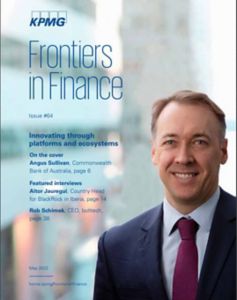Innovations that change the way value is offered to consumers threaten the integrity and resilience of the traditional banking model.
New trends in financial service offerings such as embedded finance and decentralized finance threatens the integrity of the traditional banking business model. Examples include Uber’s embedded payments and Afterpay’s cannibalization of unsecured consumer credit. These trends also eroded the value of the ‘trust premium’ banks have held for so long. For example, Nano Home Loans, a non-bank fintech lender established in 2019, offers to approve home loans at highly competitive rates within ten minutes of an online application; this value proposition has resulted in faster-than-system growth rates.
While fintech and innovators dismember the banking value chain, incumbents also face the very real threat of highly capitalized tech giants. Many with deep customer connections and loyalty, are stepping directly into financial services, potentially redefining the category. For example, although Google has abandoned plans to launch Google Plex (a transaction account for Google Pay), the proposition found strong consumer endorsement of innovative features that embedded financial services into everyday lifestyle choices.
Finally, regulators are deliberately adjusting their posture to help increase competition (e.g., open banking) and reduce entry barriers (e.g., the Restricted ADI offers a limited risk fast track for small challenger banks to start operating as a bank in Australia). Consequently, banks are (and should be) exploring alternative business models to deepen their value pools, entrench customer relationships and expand their value propositions.
As banks evolve their market role, they will likely also need to adapt their business models. Many of the innovations that have been a threat may also be a source of strategic strength as they incorporate them to complement their core.
Adapting the business model — platforms and ecosystems

By adopting these innovative business model options, banks can complement their basic banking model (deposits, loans, transactions) and market strengths (e.g., scale of customer franchise, valuable banking licenses, strength of balance sheet) with new value propositions to help differentiate and deepen customer relationships.
For example, Goldman Sachs pivoted to become more like a platform, expanding its portfolio into consumer banking by deploying the Marcus offering, including a credit card partnership with Apple. A goal for Marcus has been to establish banking as-a-service — a platform business.
Meanwhile, DBS Singapore has built DBS Marketplace to orchestrate ecosystems of partnerships offering value propositions shaped to address specific lifecycle needs experienced by their customers, such as car ownership. This ecosystem model deepens the bank’s relationship with their customers and keeps value circulating within the ecosystem.
Essential building blocks
Three foundational capability building blocks are essential to establish either platform or ecosystem, business models:
- Value orchestration: This includes establishing, coordinating and governing participation (partner management) while also measuring the value of involvement (ecosystems or platforms) to help generate more value than the sum of the parts.
- Data-driven insights: This is the ability to convert raw data into valuable insights on customers and operations. Harnessing the power of data can lead to continuous improvement, validation through experimentation and innovation (including accidental discovery through sophisticated pattern analysis); increasingly, this is machine-driven as AI and other advanced analytics tools become mainstream and accessible.
- Digital interoperability: This refers kpmg.com.au to the ability to safely exchange information and drive functionality between participants, including orchestrating end-to-end processes across multiple participants.
Bringing these to life in a banking context involves building blocks that need to be augmented by the basic banking capabilities of financial management, payments, and risk management.
Payments are a significant capability for banks battling for consumer relevancy. Payments provide a cohesive capability for both platforms or ecosystems and maintains a connection with the basic banking value proposition (cash, credit, and transaction). It also works to generate valuable contextual and behavioral data.
A roadmap for adoption
In KPMG professionals’ experience, banks that choose to adapt and future proof their business model should start the transformation by exploring three steps (see Fig. 2).
Assess capability maturity: Does the bank have the foundational capabilities needed to deploy the future business model effectively? If not, start work immediately as this is an investment with no regrets, while, in parallel, work on the other two steps.
Evaluate the bank’s role in the market: How will the bank differentiate along the spectrum of a ‘utility bank’ to an ‘intimate bank’? This can be unlocked by looking at what strengths the bank already has (e.g., if its cost discipline, it may be more suited to a ‘utility’ play).
Identify adaptions to the current business model: Does the bank need to adapt its historical business model by incorporating a platform or ecosystem play?
Fig. 2. Roadmap to adapt the banking business model

Call to action
The banking industry faces a volatile future, but one that is rich with opportunity. KPMG professionals believe banks that prepare to adapt their business models now by establishing the basic capabilities of the future and agreeing between the board and executive on the bank’s role will likely be best positioned to take advantage of those rich opportunities.
This article is featured in Frontiers in Finance – Resilient and relevant
Explore other articles › Subscribe to receive the latest financial services insights directly to your inbox ›
Connect with us
- Find office locations kpmg.findOfficeLocations
- kpmg.emailUs
- Social media @ KPMG kpmg.socialMedia
Stay up to date with what matters to you
Gain access to personalized content based on your interests by signing up today
Explore more chapters





